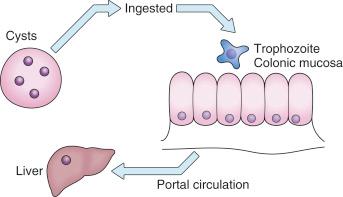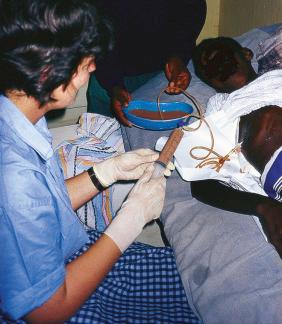Physical Address
304 North Cardinal St.
Dorchester Center, MA 02124
Hepatic abscesses are most commonly pyogenic in Western countries, but amebic abscesses are common in areas of the world where Entamoeba histolytica is endemic. Less frequent causes include fungal and tuberculous abscesses.
Diagnosis of hepatic abscess relies on good history taking and simple imaging.
The differentiation between amebic and pyogenic hepatic abscess (as well as fungal or tubercular abscess) relies on an adequate history (including travel history), imaging pattern, culture results, and serologic testing.
A history of dysentery or diarrhea is present in only 20% of patients with an amebic liver abscess (ALA). Amebic liver abscess is readily treated by antibiotics and luminal amebicides.
Pyogenic liver abscess is a life-threatening condition, resulting from infected blood or bile. Abscesses are frequently polymicrobial and include anaerobic organisms. Treatment is with appropriate antibiotics and drainage.
The most common infective cause of hepatic cysts worldwide is Echinococcus granulosus, the agent of hydatid disease; other noninfective causes include simple cysts, tumors, congenital biliary diseases, and polycystic disease.
Worldwide, 480 million people are infected with Entamoeba histolytica.
Amebic infection may be asymptomatic or may manifest as dysentery, ALA, or other (rarer) manifestations.
The diagnosis and management of ALA have been revolutionized by advances in imaging and interventional radiology.
Treatment now relies almost entirely on drug therapy.
Amebic liver abscess is caused by the protozoan E. histolytica . The reservoir of infection is human ( Fig. 30.1 ).

The infective form is the cyst (12 μm in diameter), which is ingested. Excystation occurs in the small intestine. The trophozoite (10 to 60 μm) infects the colon and may cause inflammation and dysentery. Amebae spread to the liver through the portal circulation.
The cyst is able to survive outside the body for weeks or months, whereas the trophozoite degenerates in minutes.
Amebae may be pathogenic or nonpathogenic. The nonpathogenic form has been reclassified as Entamoeba dispar. Pathogenic species can be differentiated from nonpathogenic species by the following:
Zymodeme analysis: 22 distinct isoenzyme patterns (zymodemes) on electrophoresis have been isolated.
RNA and DNA probes
Infection with E. histolytica affects 10% of the world’s population ; 40 to 50 million people develop amebic colitis or ALA, and 40,000 to 100,000 deaths occur each year.
The prevalence of infection varies from <1% in industrialized countries to 50% to 80% in some tropical regions.
Spread is by the fecal-oral route and is increased by the following:
Poor sanitation
Contamination of food by flies
Unhygienic food handling
Unclean water
Use of human feces as fertilizer
High-risk groups:
Persons of lower socioeconomic status in endemic areas
Immigrants from endemic areas
Institutionalized populations (e.g., inpatients of psychiatric hospitals)
Men who have sex with men
Travelers
Persons who are immunosuppressed, including those with human immunodeficiency virus (HIV) infection
In the liver, E. histolytica lyses the host’s tissue with proteolytic enzymes contained in cytoplasmic vacuoles.
The hepatic lesion is a well-demarcated abscess consisting of necrotic liver and usually affecting the right lobe. The initial host response to the ameba is neutrophil migration, but the ameba can also lyse neutrophils, thus releasing their enzymes and assisting in the process of tissue destruction.
The abscess contains acellular debris; amebic trophozoites are found only at the periphery of the lesion, where they can invade further.
The following host factors contribute to the severity of disease:
Age (children more than adults)
Pregnancy
Malnutrition and alcoholism
Glucocorticoid use
Malignant disease
ALA manifests with amebic colitis in fewer than 10% of cases.
Patients may have a past history of diarrhea or dysentery.
E. histolytica can be isolated from the stool in approximately 50% of cases.
Socioeconomic and demographic features
Emigrant from or resident in an endemic area
Traveler to an endemic area
Men more than women (3 to 10 times)
Young adults more than children or elderly persons
Symptoms
Fever, rigors, night sweats
Nausea, anorexia, malaise
Right upper quadrant abdominal discomfort
Weight loss
Chest symptoms: Dry cough, pleuritic pain
Diaphragmatic irritation: Shoulder tip pain, hiccups
Physical examination
Fever
Tender hepatomegaly
Chest signs: Dull right base (usually from raised hemidiaphragm); crackles at right base; pleural rub
Jaundice and peritonitis or pericardial rub are rare and poor prognostic signs.
Laboratory findings ( Table 30.1 )
An increased serum bilirubin level is uncommon.
| Laboratory Finding | Frequency (%) or Comment |
|---|---|
| Leukocytosis | 80 |
| Elevated serum alkaline phosphatase level | 80 |
| Anemia | >50 |
| Increased erythrocyte sedimentation rate | Common |
| Proteinuria | Common |
| Elevated serum aminotransferase levels | Poor prognostic sign |
Diagnostic imaging
Chest film
Elevation of right hemidiaphragm
Blunting of right costophrenic angle
Atelectasis
Ultrasonography
Round or oval single lesion (sometimes multiple)
Lack of significant wall echoes, so the transition from abscess to normal liver is abrupt
Hypoechoic appearance compared with normal liver; diffuse echoes throughout abscess
Peripheral location, close to liver capsule
Distal enhancement
Computed tomography (CT)
Well-defined lesions, round or oval, mostly single (sometimes multiple)
Low density compared with surrounding liver tissue
Nonhomogeneous internal structure
Magnetic resonance imaging (MRI)
Abscess characterized by low signal intensity on T1-weighted images and high signal intensity on T2-weighted images
Radionuclide imaging
ALA appears as a cold spot, apparently distinguishing it from a pyogenic abscess; this modality has not been researched extensively for this use.
Serologic tests: The detection of antibodies is the mainstay of diagnosis of invasive amoebiasis. Positive serologic tests are found in 95% to 100% of patients with ALA , even if they have received some antiamebic therapy.
Commercial enzyme-linked immunosorbent assay (ELISA) is most commonly used and has a sensitivity and specificity as high as 97.9% and 94.8%, respectively.
The ELISA is positive in all forms of invasive amebic disease (including dysentery). Serologic tests may remain positive for a prolonged period even after treatment of ALA. Combined testing may be necessary for accurate diagnosis.
The cellulose acetate precipitation (CAP) test is highly sensitive and specific; it becomes negative quickly after successful treatment and is regarded as a reference test for amebic serology.
Aspiration of abscess (when the diagnosis is uncertain or rupture is imminent)
Yellow to dark brown “anchovy sauce”
Odorless
“Pus” consisting mainly of acellular debris; most amebae are found in the abscess wall.
Absence of bacteria on culture (mixed amebic and pyogenic abscesses more commonly reported especially with nucleic acid diagnostic techniques)
Polymerase chain reaction (PCR) testing for E. histolytica confirms the diagnosis.
Rupture of abscess into the following:
Chest, causing
Hepatobronchial fistula (± expectoration of “anchovy” pus)
Lung abscess
Amebic empyema
Pericardium, causing
Heart failure
Pericarditis
Cardiac tamponade (often fatal; may be followed by constrictive pericarditis)
Peritoneum, causing
Peritonitis
Ascites
Secondary infection is usually iatrogenic following aspiration.
Other complications (rare)
Acute liver failure
Hemobilia
Inferior vena cava obstruction
Budd-Chiari syndrome
Hematogenous spread causing cerebral abscess
Factors predisposing to complications
Age >40 years
Concomitant glucocorticoid use
Multiple abscesses
Large abscess (>10 cm in diameter)
Erythrocyte sedimentation rate (ESR) and C-reactive protein levels are reported to be high in patients who present with or develop systemic complications.
Treatment of amebic liver abscess is usually with drugs alone.
Commonly used regimens (administered orally)
Metronidazole 750 mg three times daily for 5 to 10 days (pediatric, 35 to 50 mg/kg per day in three divided doses for 5 days), or
Tinidazole 2 g/day for 3 days (pediatric, 50 to 60 mg/kg daily for 5 days), or
Chloroquine 1 g loading dose for 1 to 2 days, then 500 mg/day for 20 days (pediatric, 10 mg/kg base).
Luminal amebicides must always be used following the aforementioned regimens.
Diloxanide furoate 500 mg three times daily (pediatric, 20 mg/kg per day in three divided doses) for 10 days, or
Diiodohydroxyquin 650 mg three times daily (pediatric, 30 to 40 mg/kg per day in three divided doses; maximum 2 g/day) for 20 days, or
Paromomycin sulfate 25 to 35 mg/kg/day in three divided doses (pediatric, 25 to 35 mg/kg per day in three divided doses) for 5 to 10 days
Optimal management
Patients with suspected ALA should be started on therapy while awaiting serologic confirmation. Response is usually rapid, with defervescence occurring in 48 to 72 hours.
In uncomplicated ALA, such as those with small solitary right lobe abscesses, there is no evidence that therapeutic aspiration, in combination with drug therapy, improves time to resolution of symptoms or reduces hospitalization.
Critically ill patients, those with left lobe abscess, or those who do not respond to initial drug therapy may require radiologically guided fine-needle aspiration to avoid rupture and to exclude a pyogenic abscess.
Complications such as rupture of the abscess may be managed medically but often require percutaneous drainage ( Fig. 30.2 ). Surgical drainage is seldom required.

Prognosis
Amebic liver abscess is an eminently treatable condition.
The mortality rate is <1% in uncomplicated disease.
Delay in diagnosis may result in abscess rupture, with a higher mortality rate.
Rupture into chest or peritoneum: 20% mortality rate
Rupture into pericardium: 32% to 100% mortality rate
Pyogenic liver abscess is a life-threatening condition.
The incidence varies but is estimated to be 8 to 20 per 100,000 hospital admissions in the United States.
Improvements in prognosis have resulted from better imaging and microbiologic analysis, but delays in diagnosis or failure to recognize this condition can result in high morbidity and mortality rates.
Pyogenic liver abscess is most frequently secondary to bile duct obstruction but is often associated with other medical conditions such as diabetes mellitus, immunosuppressive therapies, systemic infection, diverticular disease, and colorectal carcinoma.
Become a Clinical Tree membership for Full access and enjoy Unlimited articles
If you are a member. Log in here